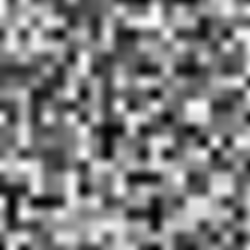之前的白噪声确实不太行,因为我们现实生活中并不是那样的完全嗡嗡。

 我们接下来就是要生成这样的纹理。
我们接下来就是要生成这样的纹理。
一维noize
 接下来看不同方式生成的一维noize
接下来看不同方式生成的一维noize
1
2
3
4
5
|
float i = floor(x); // 整数(i 代表 integer)
float f = fract(x); // 小数(f 代表 fraction)
y = rand(i); //rand() 在之前的章节提过
y = mix(rand(i), rand(i + 1.0), f);
y = mix(rand(i), rand(i + 1.0), smoothstep(0.,1.,f));
|
y = mix(rand(i), rand(i + 1.0), f);使用的是线性插值

y = mix(rand(i), rand(i + 1.0), smoothstep(0.,1.,f));顶点的变化如何变得顺滑了起来

二维Noise
在 2D 中,除了在一条线的两点(fract(x) 和 fract(x)+1.0)中插值,我们将在一个平面上的方形的四角(fract(st), fract(st)+vec2(1.,0.), fract(st)+vec2(0.,1.) 和 fract(st)+vec2(1.,1.))中插值。

1
2
3
4
5
6
7
8
9
10
11
12
13
14
15
16
17
18
19
20
21
22
23
24
25
26
27
28
29
30
31
32
33
34
35
36
37
38
39
40
41
42
43
44
45
46
47
|
uniform vec2 u_resolution;
uniform vec2 u_mouse;
uniform float u_time;
// 2D Random
float random (in vec2 st) {
return fract(sin(dot(st.xy,
vec2(12.9898,78.233)))
* 43758.5453123);
}
// 2D Noise based on Morgan McGuire @morgan3d
// https://www.shadertoy.com/view/4dS3Wd
float noise (in vec2 st) {
vec2 i = floor(st);
vec2 f = fract(st);
// Four corners in 2D of a tile
float a = random(i);
float b = random(i + vec2(1.0, 0.0));
float c = random(i + vec2(0.0, 1.0));
float d = random(i + vec2(1.0, 1.0));
// Smooth Interpolation
// Cubic Hermine Curve. Same as SmoothStep()
vec2 u = f*f*(3.0-2.0*f);
// u = smoothstep(0.,1.,f);
// Mix 4 coorners percentages
return mix(a, b, u.x) +
(c - a)* u.y * (1.0 - u.x) +
(d - b) * u.x * u.y;
}
void main() {
vec2 st = gl_FragCoord.xy/u_resolution.xy;
// Scale the coordinate system to see
// some noise in action
vec2 pos = vec2(st*20.864);
// Use the noise function
float n = noise(pos);
gl_FragColor = vec4(vec3(n), 1.0);
}
|
更多的noise
为了消除块状,我们使用gradients,而不是固定值

1
2
3
4
5
6
7
8
9
10
11
12
13
14
15
16
17
18
19
20
21
22
23
24
25
26
27
28
29
30
31
32
33
34
35
|
uniform vec2 u_resolution;
uniform vec2 u_mouse;
uniform float u_time;
vec2 random2(vec2 st){
st = vec2( dot(st,vec2(127.1,311.7)),
dot(st,vec2(269.5,183.3)) );
return -1.0 + 2.0*fract(sin(st)*43758.5453123);
}
// Value Noise by Inigo Quilez - iq/2013
// https://www.shadertoy.com/view/lsf3WH
float noise(vec2 st) {
vec2 i = floor(st);
vec2 f = fract(st);
vec2 u = f*f*(3.0-2.0*f);
return mix( mix( dot( random2(i + vec2(0.0,0.0) ), f - vec2(0.0,0.0) ),
dot( random2(i + vec2(1.0,0.0) ), f - vec2(1.0,0.0) ), u.x),
mix( dot( random2(i + vec2(0.0,1.0) ), f - vec2(0.0,1.0) ),
dot( random2(i + vec2(1.0,1.0) ), f - vec2(1.0,1.0) ), u.x), u.y);
}
void main() {
vec2 st = gl_FragCoord.xy/u_resolution.xy;
st.x *= u_resolution.x/u_resolution.y;
vec3 color = vec3(0.000,0.000,0.000);
vec2 pos = vec2(st*10.0);
color = vec3( noise(pos)*.5+.5 );
gl_FragColor = vec4(color,1.0);
}
|
流形

1
2
3
4
5
6
7
8
9
10
11
12
13
14
15
16
17
18
19
20
21
22
23
24
25
26
27
28
29
30
31
32
33
34
35
36
37
38
39
40
|
uniform vec2 u_resolution;
uniform vec2 u_mouse;
uniform float u_time;
vec2 random2(vec2 st){
st = vec2( dot(st,vec2(127.1,311.7)),
dot(st,vec2(269.5,183.3)) );
return -1.0 + 2.0*fract(sin(st)*43758.5453123);
}
// Value Noise by Inigo Quilez - iq/2013
// https://www.shadertoy.com/view/lsf3WH
float noise(vec2 st) {
vec2 i = floor(st);
vec2 f = fract(st);
vec2 u = f*f*(3.0-2.0*f);
return mix( mix( dot( random2(i + vec2(0.0,0.0) ), f - vec2(0.0,0.0) ),
dot( random2(i + vec2(1.0,0.0) ), f - vec2(1.0,0.0) ), u.x),
mix( dot( random2(i + vec2(0.0,1.0) ), f - vec2(0.0,1.0) ),
dot( random2(i + vec2(1.0,1.0) ), f - vec2(1.0,1.0) ), u.x), u.y);
}
void main() {
vec2 st = gl_FragCoord.xy/u_resolution.xy;
st.x *= u_resolution.x/u_resolution.y;
vec3 color = vec3(0.0);
float t = 1.0;
// Uncomment to animate
// t = abs(1.0-sin(u_time*.1))*5.;
// Comment and uncomment the following lines:
st += noise(st*2.)*t; // Animate the coordinate space
color = vec3(1.) * smoothstep(.18,.2,noise(st)); // Big black drops
color += smoothstep(.15,.2,noise(st*10.)); // Black splatter
color -= smoothstep(.35,.4,noise(st*10.)); // Holes on splatter
gl_FragColor = vec4(1.-color,1.0);
}
|
多边形

1
2
3
4
5
6
7
8
9
10
11
12
13
14
15
16
17
18
19
20
21
22
23
24
25
26
27
28
29
30
31
32
33
34
35
36
37
38
39
40
41
42
43
44
45
46
47
48
49
50
51
52
53
54
|
uniform vec2 u_resolution;
uniform vec2 u_mouse;
uniform float u_time;
vec2 random2(vec2 st){
st = vec2( dot(st,vec2(127.1,311.7)),
dot(st,vec2(269.5,183.3)) );
return -1.0 + 2.0*fract(sin(st)*43758.5453123);
}
float noise(vec2 st) {
vec2 i = floor(st);
vec2 f = fract(st);
vec2 u = f*f*(3.0-2.0*f);
return mix( mix( dot( random2(i + vec2(0.0,0.0) ), f - vec2(0.0,0.0) ),
dot( random2(i + vec2(1.0,0.0) ), f - vec2(1.0,0.0) ), u.x),
mix( dot( random2(i + vec2(0.0,1.0) ), f - vec2(0.0,1.0) ),
dot( random2(i + vec2(1.0,1.0) ), f - vec2(1.0,1.0) ), u.x), u.y);
}
mat2 rotate2d(float _angle){
return mat2(cos(_angle),-sin(_angle),
sin(_angle),cos(_angle));
}
float shape(vec2 st, float radius) {
st = vec2(0.5)-st;
float r = length(st)*2.0;
float a = atan(st.y,st.x);
float m = abs(mod(a+u_time*2.,3.14*2.)-3.14)/3.6;
float f = radius;
m += noise(st+u_time*0.1)*.5;
// a *= 1.+abs(atan(u_time*0.2))*.1;
// a *= 1.+noise(st+u_time*0.1)*0.1;
f += sin(a*50.)*noise(st+u_time*.2)*.1;
f += (sin(a*20.)*.1*pow(m,2.));
return 1.-smoothstep(f,f+0.007,r);
}
float shapeBorder(vec2 st, float radius, float width) {
return shape(st,radius)-shape(st,radius-width);
}
void main() {
vec2 st = gl_FragCoord.xy/u_resolution.xy;
vec3 color = vec3(1.0) * shapeBorder(st,0.8,0.02);
gl_FragColor = vec4( 1.-color, 1.0 );
}
|

 我们接下来就是要生成这样的纹理。
我们接下来就是要生成这样的纹理。 接下来看不同方式生成的一维noize
接下来看不同方式生成的一维noize




